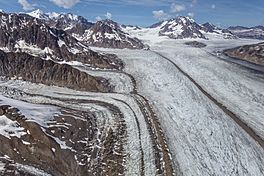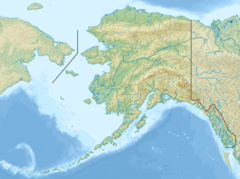Tana Glacier facts for kids
Quick facts for kids Tana Glacier |
|
|---|---|

Western Tributary of Tana Glacier
|
|
| Type | Valley glacier |
| Coordinates | 60°43′53″N 142°43′51″W / 60.73139°N 142.73083°W |
| Length | 17 miles (27 km) |
| Terminus | outwash plains |
| Status | retreating |
Tana Glacier is a huge river of ice, about 17 miles (27 km) long, located in the state of Alaska, U.S.. It's a type of glacier that flows through a valley, much like a very slow-moving river. This amazing natural feature starts high up in the mountains at a place called the Bagley Icefield. From there, it slowly moves northwest, eventually reaching the area near the beginning of the Tana River.
The name "Tana" comes from the Alaska Native people who have lived in the region for a very long time. Prospectors, who were people looking for valuable minerals, first wrote down the name in 1900.
About Tana Glacier
Tana Glacier is a large and important part of Alaska's icy landscape. It's known as a valley glacier because it flows down through a valley, carving out the land as it moves. Glaciers are like giant, slow-moving ice machines that shape mountains and valleys over thousands of years.
Where is Tana Glacier Located?
This impressive glacier is found in the Valdez-Cordova Census Area in Alaska. Alaska is the largest state in the U.S. and is famous for its vast wilderness, towering mountains, and many glaciers. Tana Glacier is just one of many glaciers in this cold and beautiful region.
What is a Glacier?
A glacier is a huge mass of ice that moves slowly over land. It forms when snow piles up over many years, compacting into ice. When the ice gets thick enough, gravity pulls it downhill. Glaciers are often called "rivers of ice" because they flow, though much slower than water.
Glaciers are important because they store a lot of the world's fresh water. They also help us understand how Earth's climate is changing.
How Glaciers Change
The end of a glacier is called its terminus. For Tana Glacier, its terminus in 1950 was near the head of the Tana River. Glaciers can grow or shrink depending on how much snow falls and how much ice melts. Tana Glacier is currently retreating, which means its terminus is moving back. This happens when the ice melts faster than new snow can build up.
The weather around Tana Glacier is very cold. The warmest month is usually August, but even then, the average temperature is around -2 °C (28 °F). The coldest month is January, with temperatures dropping to about -20 °C (-4 °F). These freezing temperatures are why the glacier can exist and move.


